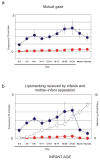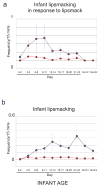Reciprocal face-to-face communication between rhesus macaque mothers and their newborn infants
- PMID: 19818617
- PMCID: PMC2784245
- DOI: 10.1016/j.cub.2009.08.055
Reciprocal face-to-face communication between rhesus macaque mothers and their newborn infants
Abstract
Human mothers interact emotionally with their newborns through exaggerated facial expressions, speech, mutual gaze, and body contact, a capacity that has long been considered uniquely human [1-4]. Current developmental psychological theories propose that this pattern of mother-infant exchange promotes the regulation of infant emotions [4-6] and serves as a precursor of more complex forms of social exchange including perspective taking and empathy. Here we report that in rhesus macaques, mother-infant pairs also communicate intersubjectively via complex forms of emotional exchanges including exaggerated lipsmacking, sustained mutual gaze, mouth-mouth contacts, and neonatal imitation. Infant macaques solicit their mother's affiliative responses and actively communicate to her. However, this form of communication disappears within the infant's first month of life. Our data challenge the view that the mother-infant communicative system functions in order to sustain proximity and that infants are simply passive recipients in such interaction. Thus, emotional communication between mother and infant is not uniquely human. Instead, we can trace back to macaques the evolutionary foundation of those behaviors that are crucial for the establishment of a functional capacity to socially exchange with others.
Figures




Comment in
-
Social cognition: Evolutionary history of emotional engagements with infants.Curr Biol. 2009 Nov 3;19(20):R941-3. doi: 10.1016/j.cub.2009.09.037. Curr Biol. 2009. PMID: 19889368
References
-
- Stern DN. The interpersonal world of the infant: a view from psychoanalysis and developmental psychology. New York: Basic Books; 1985.
-
- Trevarthen C. Conversation with a two-month-old. New Scientist. 1974;2:230–235.
-
- Trevarthen C. The foundation of intersubjectivity: Development of interpersonal and cooperative understanding in infants. In: Olson D, editor. The Social Foundation of Language and Thought. New York: Norton; 1980. pp. 316–342.
-
- Tronick EZ. Emotions and emotional communication in infants. Am Psychologist. 1989;44:112–126. - PubMed
-
- Trevarthen C, Aitken KJ. Infant intersubjectivity: research, theory and clinical applications. J Child Psycol Psychiat. 2001;42:3–48. - PubMed
Publication types
MeSH terms
Grants and funding
LinkOut - more resources
Full Text Sources

